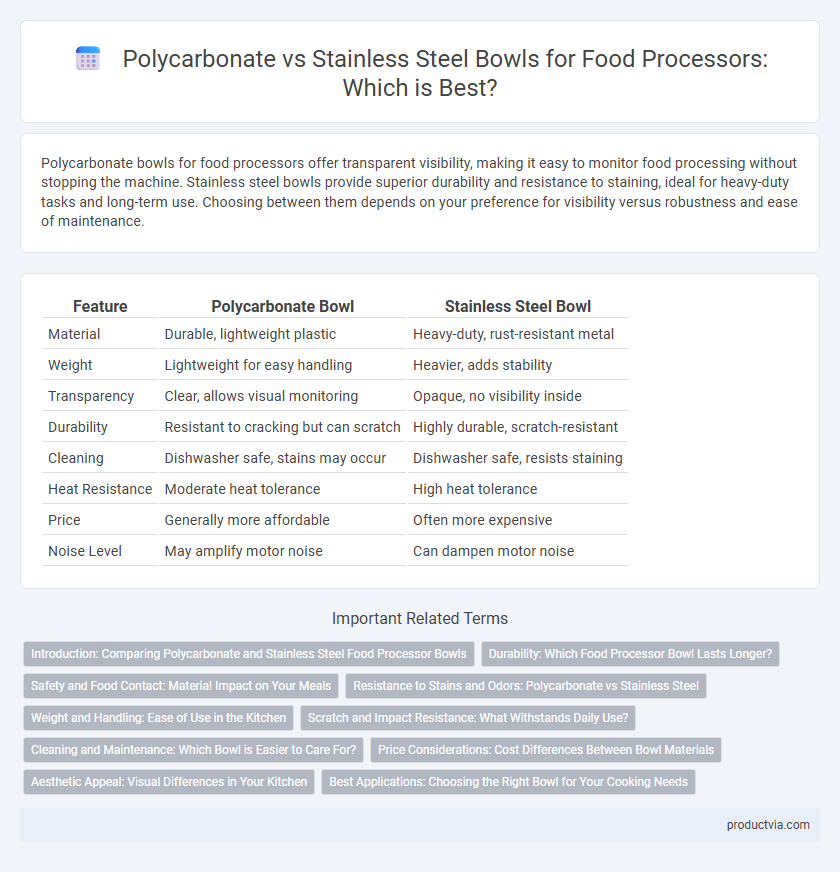Polycarbonate bowls for food processors offer transparent visibility, making it easy to monitor food processing without stopping the machine. Stainless steel bowls provide superior durability and resistance to staining, ideal for heavy-duty tasks and long-term use. Choosing between them depends on your preference for visibility versus robustness and ease of maintenance.
Table of Comparison
| Feature | Polycarbonate Bowl | Stainless Steel Bowl |
|---|---|---|
| Material | Durable, lightweight plastic | Heavy-duty, rust-resistant metal |
| Weight | Lightweight for easy handling | Heavier, adds stability |
| Transparency | Clear, allows visual monitoring | Opaque, no visibility inside |
| Durability | Resistant to cracking but can scratch | Highly durable, scratch-resistant |
| Cleaning | Dishwasher safe, stains may occur | Dishwasher safe, resists staining |
| Heat Resistance | Moderate heat tolerance | High heat tolerance |
| Price | Generally more affordable | Often more expensive |
| Noise Level | May amplify motor noise | Can dampen motor noise |
Introduction: Comparing Polycarbonate and Stainless Steel Food Processor Bowls
Polycarbonate food processor bowls are lightweight, transparent, and resistant to impact, allowing easy monitoring of ingredients during processing. Stainless steel bowls offer superior durability, corrosion resistance, and a sleek appearance, making them ideal for heavy-duty chopping and mixing tasks. Choosing between polycarbonate and stainless steel depends on the desired balance between visibility, weight, and long-term robustness for kitchen use.
Durability: Which Food Processor Bowl Lasts Longer?
Stainless steel bowls for food processors offer superior durability due to their resistance to cracks, stains, and warping compared to polycarbonate bowls, which may develop scratches or become cloudy over time. Polycarbonate bowls, while lightweight and clear for easy monitoring, are more prone to wear and can degrade with exposure to harsh cleaning chemicals and high temperatures. Overall, stainless steel bowls tend to last longer, making them ideal for heavy-duty use and longevity in food processing tasks.
Safety and Food Contact: Material Impact on Your Meals
Polycarbonate bowls for food processors are lightweight and transparent but may release BPA or other chemicals if damaged or exposed to high temperatures, raising safety concerns during food contact. Stainless steel bowls provide a non-reactive, durable surface that resists staining and does not leach harmful substances, ensuring safer meal preparation. Choosing stainless steel enhances hygiene and maintains the purity of your ingredients without risk of chemical contamination.
Resistance to Stains and Odors: Polycarbonate vs Stainless Steel
Polycarbonate bowls for food processors are prone to retaining stains and odors from strongly colored or aromatic foods due to their porous surface, while stainless steel bowls resist staining and odor absorption thanks to their non-porous, smooth finish. Stainless steel also offers superior durability against discoloration and does not retain lingering smells, making it ideal for preparing diverse ingredients without cross-contamination concerns. Polycarbonate may require more intensive cleaning to eliminate persistent odors and dyes compared to the easily washable, stain-resistant nature of stainless steel.
Weight and Handling: Ease of Use in the Kitchen
Polycarbonate bowls are lightweight and transparent, making it easier to monitor food processing and handle the food processor during use. Stainless steel bowls, while heavier, offer enhanced durability and stability, reducing the risk of movement during high-speed processing. The lighter weight of polycarbonate improves maneuverability and ease of storage, whereas stainless steel's weight contributes to a more solid, steady feel in the kitchen.
Scratch and Impact Resistance: What Withstands Daily Use?
Polycarbonate bowls for food processors offer excellent impact resistance, making them less prone to cracking or breaking during daily use, while stainless steel bowls excel in scratch resistance, maintaining a smooth surface even after frequent contact with sharp utensils. Polycarbonate is more transparent, allowing users to monitor food processing visually, whereas stainless steel's durability provides long-term resistance to scuffs and abrasions. Both materials withstand daily food preparation tasks, but users seeking clarity and lighter weight may prefer polycarbonate, while those prioritizing scratch resistance and durability often choose stainless steel.
Cleaning and Maintenance: Which Bowl is Easier to Care For?
Polycarbonate bowls for food processors are lightweight and dishwasher safe, making cleaning quick and convenient, but they may scratch and stain over time, requiring careful maintenance to avoid damage. Stainless steel bowls resist stains and odors, maintain their appearance longer, and typically require only hand washing with mild detergent to preserve their finish. For easier upkeep, stainless steel bowls offer durable, low-maintenance care compared to polycarbonate bowls that need more cautious cleaning practices.
Price Considerations: Cost Differences Between Bowl Materials
Polycarbonate bowls for food processors typically offer a more budget-friendly option compared to stainless steel bowls, making them attractive for cost-conscious buyers. Stainless steel bowls, while generally more expensive, provide enhanced durability and resistance to staining and odors. The price difference reflects material costs and manufacturing processes, with polycarbonate bowls often found in entry-level models and stainless steel bowls in premium appliances.
Aesthetic Appeal: Visual Differences in Your Kitchen
Polycarbonate bowls offer a clear, transparent look that allows you to see the ingredients being processed, adding a modern and sleek aesthetic to your kitchen. Stainless steel bowls provide a polished, metallic finish that complements contemporary and industrial kitchen designs, giving a professional and durable appearance. Choosing between these materials impacts the visual harmony of your kitchen space, with polycarbonate enhancing a light and airy feel, while stainless steel contributes to a bold, timeless style.
Best Applications: Choosing the Right Bowl for Your Cooking Needs
Polycarbonate bowls excel in versatility and visibility, making them ideal for tasks that require monitoring consistency, such as blending smoothies or pureeing sauces. Stainless steel bowls are preferred for heavy-duty applications like kneading dough or processing hot ingredients, thanks to their durability and heat resistance. Selecting the right bowl enhances efficiency by matching material properties to specific cooking functions.
Polycarbonate bowl vs Stainless steel bowl for food processor Infographic

 productvia.com
productvia.com